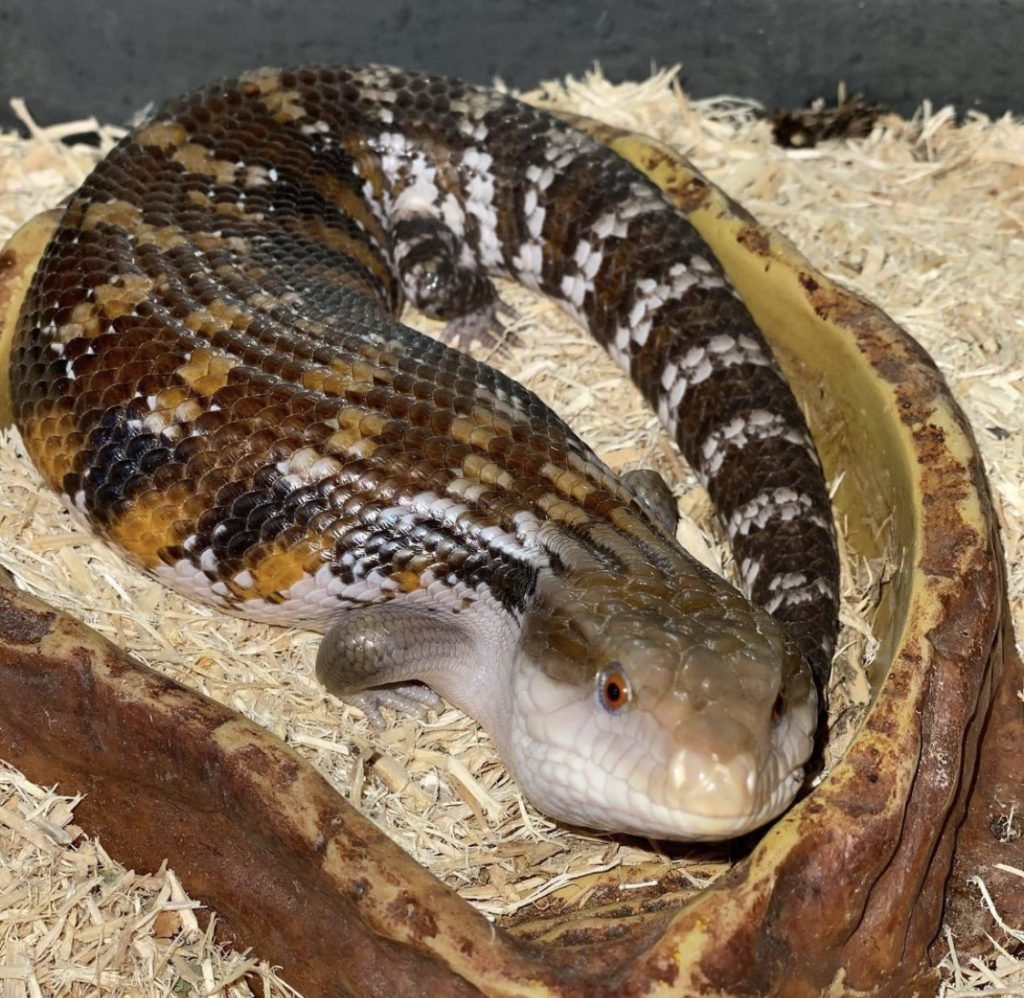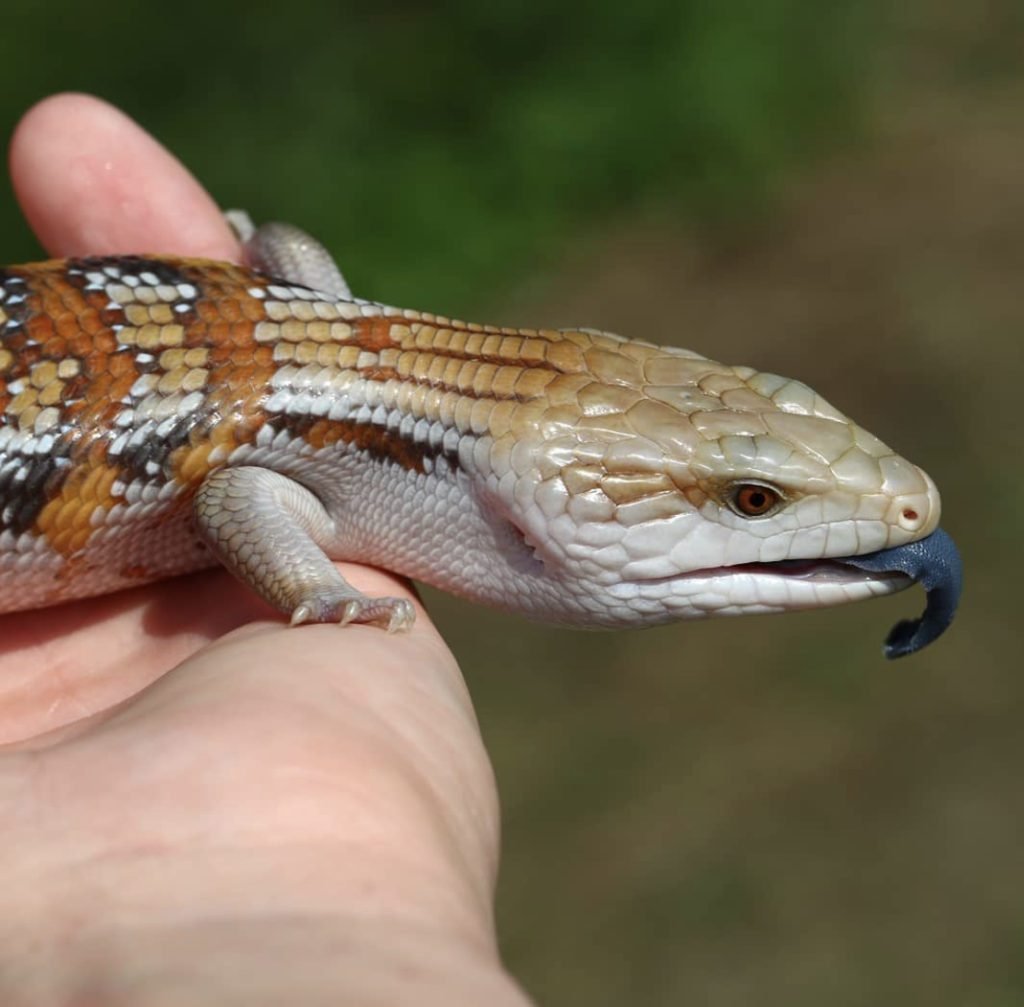Blue tongue skinks are a fascinating and unique type of lizard commonly kept as pets. As the name suggests, these reptiles have brilliant blue tongues to communicate with other skinks and intimidate predators. But there’s much more to these creatures than just their colorful mouths. This article will explore the critical aspects of blue-tongued skinks, including their diet, size, care, bite, and lifespan, to help you better understand and appreciate these fascinating reptiles.
Blue tongue skink Diet
The blue-tongued skink is a complete omnivore, enjoying plant and animal matter. They may eat anything from insects, snails, and slugs to fruit, vegetables, and even little rodents in the wild. As pets, blue-tongued skinks can eat commercial pellets, fresh vegetables and fruits, and crickets or mealworms. It’s crucial to provide them with a diet that provides all the nutrients they demand.
Nutritional requirements of blue-tongued skinks
Provide your blue-tongued skink with varied, healthy food to keep it in good condition. Insects or commercial pellets provide the high-quality protein that they need. Also necessary is a calcium supply, which can come from supplements or foods like kale, collard greens, and mustard greens. It would help if you talked to your vet or a reptile specialist to ensure your blue-tongued skink is eating the right food. A diet that is too heavy in fat or lacking in nutrients might cause health problems.

Blue tongue skink Size
Most species of blue-tongued skink are medium-sized lizards that grow to a length of 18-24 inches. Yet, there is a wide variety of sizes among the many species, from as little as 10 inches to as much as 30 inches. Environmental variables, nutrition, and heredity can modify a blue-tongued skink’s size.
Factors affecting their growth and development
To help your blue-tongued skink grow and develop, give it an appropriate home with many areas to roam around and explore. As they are ectothermic, temperature and humidity affect their growth and development. Providing them with the right living conditions is fundamental to their growth and wellness.
You may also interest: Don’t Miss Out on These Incredible Kinds of Bearded Dragons
Blue tongue skink Care
Taking care of a blue-tongued skink involves more than just providing them with food and water. These reptiles require specific living conditions and daily maintenance to ensure their health and well-being. Proper care includes:
- Creating a suitable habitat.
- Maintaining temperature and humidity levels.
- Providing clean water.
- Regular veterinary check-ups.
How to create an ideal habitat for blue-tongued skinks
You’ll need a spacious cage with hiding spots, basking spots, and water for your blue-tongued skink. The enclosure should also include a heating and lighting system to simulate their natural habitat. The terrarium remains cleaned and disinfected regularly to avoid the formation of parasites and germs.

Do Blue tongue skink Bite?
Although blue-tongued skinks are generally docile and friendly, they can bite if they feel threatened or frightened. Knowing how to avoid and treat bites is vital since they can hurt and cause infection.
How to avoid getting bitten
Handling blue tongue skink gently and with care is essential to avoid getting bitten by a blue-tongued skink. Avoid sudden movements or loud noises that may startle them, and never grab them by the tail or head. If you need to pick them up, support their body and allow them to crawl onto your hand or arm. You should also avoid handling them during feeding times, as they may be more likely to bite if they mistake your hand for food.
What to do if you get bitten
If bitten by a blue-tongued skink, clean the wound and seek medical assistance. Blue-tongued skinks are not poisonous, but their bites can hurt and cause an infection if not treated. They may cause allergic reactions or other issues.
Do Blue tongue skink Lifespan
A blue-tongued skink’s lifespan varies depending on its species, genetics, and living conditions. On average, they can live up to 20 years or more in captivity if provided with proper care and a suitable environment.
Tips for promoting a long and healthy life
A well-balanced food, adequate living circumstances, and frequent veterinarian check-ups can help your blue-tongued skink live long and healthy. Keep an eye out for strange behavior, loss of appetite, or drowsiness as possible indicators of sickness or injury.
You may also interest: Pogona Barbata vs Pogona Vitticeps: Which Bearded Dragon Reigns Supreme?

Do Blue tongue skink Lifespan
The price of a blue-tongued skink can vary depending on factors such as their species, age, and source. They range from around $100 to over $1000, with rarer species and younger animals typically costing higher prices.
Where to buy blue-tongued skinks
You can get a blue-tongued skink from a good pet store, a breeder, or even online. Study and find a trusted provider to acquire a healthy, well-cared-for animal.
Do Blue tongue skink Lifespan
Behavioral and physical differences exist between male and female blue-tongued skinks. Men are often slightly taller and more robust than women, having greater statures overall. The hemipenal bulge, an indicator of the reproductive system, may also be more noticeable. While males tend to have broad shoulders and heads, ladies are typically shorter and thinner.
Behavioral differences between male and female blue tongue skinks
When mating season approaches, male blue-tongued skinks may become more territorial and aggressive than females. They may engage in aggressive actions like head-bobbing and tail-thrashing to prove their superiority to other males. Women may be safely confined in large groups since they are friendlier and more sociable. Similarly, they may engage in maternal activities, including nest-digging and brood protection.
Blue tongue skinks are fascinating and unique reptiles that make exciting and rewarding pets. By understanding their diet, size, care, bite, lifespan, and other related aspects, you can provide them with the best possible care and enjoy their company for many years. Whether you’re a seasoned reptile owner or just starting, blue-tongued skinks are an excellent choice for anyone looking for a fun and engaging pet.

FAQ about Blue Tongue Skink
What is a blue-tongued skink?
A blue-tongued skink is a lizard native to Australia and parts of Indonesia. They are known for their blue tongues and unique appearance.
What does a blue-tongued skink look like?
Blue-tongued skinks can vary in color and pattern depending on the species. They typically have thick bodies, short legs, and triangular heads. They also have a wide, flat tongue that is blue.
What is the diet of a blue-tongued skink?
Blue-tongued skinks are omnivorous, meaning they eat both plants and animals. Their diet can include insects, fruits, vegetables, and even small mammals or reptiles.
How big do blue-tongued skinks get?
Blue-tongued skinks can range in size depending on the species. They can grow to be anywhere from 12 to 24 inches long.
What kind of environment do blue-tongued skinks need?
Blue-tongued skinks need a warm and humid environment to thrive. They require a habitat with a basking spot, hiding places, and a water dish.
Do blue-tongued skinks make good pets?
Yes, blue-tongued skinks make great pets for experienced reptile owners. They are docile and can be easily tamed with proper handling.
How long do blue-tongued skinks live?
Blue-tongued skinks can live up to 20 years or more in captivity if provided with proper care and a suitable environment.
Are blue-tongued skinks venomous?
No, blue-tongued skinks are not venomous. However, their bite can still be painful and may result in infection if not properly treated.
How do you handle a blue-tongued skink?
To handle a blue-tongued skink, it’s essential to do so gently and with care. Avoid sudden movements or loud noises that may startle them and support their body when picking them up.
How often do blue-tongued skinks need to be fed?
Blue-tongued skinks should be fed every 2-3 days, with a well-balanced diet that includes animal and plant-based foods.
Do blue-tongued skinks need a UVB light?
Blue-tongued skinks require a UVB light in their habitat to help them process calcium and maintain proper health.
Can blue-tongued skinks be housed together?
It is not recommended to house multiple, blue-tongued skinks, as they may become territorial and aggressive towards each other.
What should I do if my blue tongue skink stops eating?
If your blue-tongued skink stops eating, it could signify illness or stress. Consult with a veterinarian or experienced reptile owner for advice.
How can I tell if my blue-tongued skink is male or female?
Male blue-tongued skinks are typically more extensive and robust than females, with broader heads and heavier bodies. They may also have a more prominent hemipenal bulge. Females tend to be smaller and leaner, with more slender faces and bodies.
How much does a blue-tongued skink cost?
The cost of a blue-tongued skink can vary depending on factors such as species, age, and source. They range from around $100 to over $1000, with rarer species and younger animals typically commanding higher prices.

